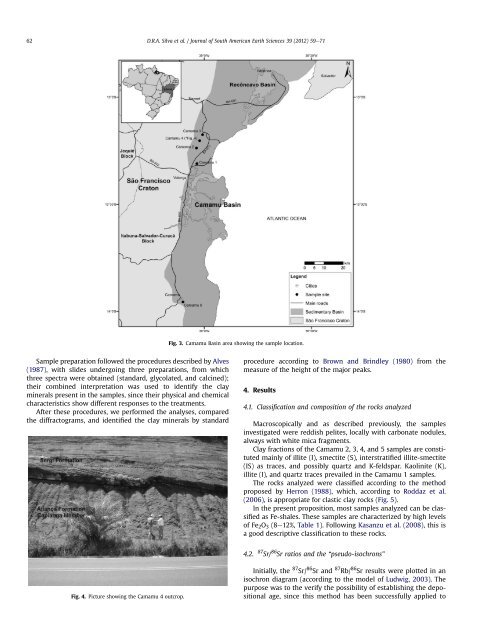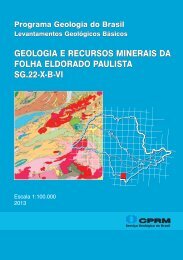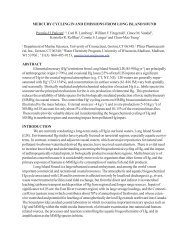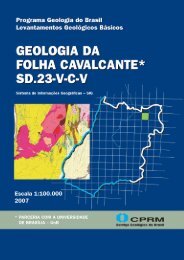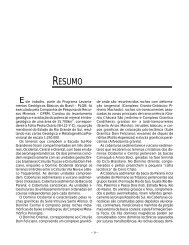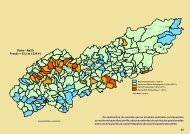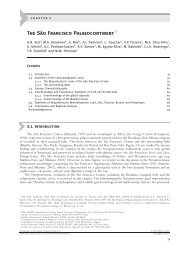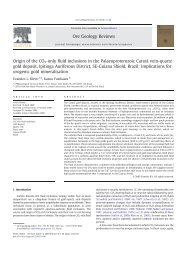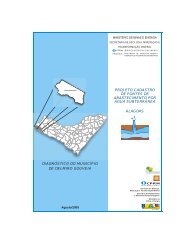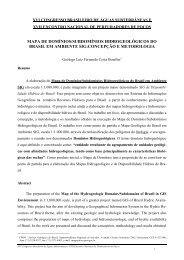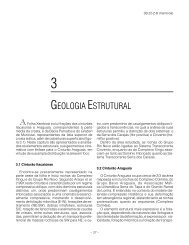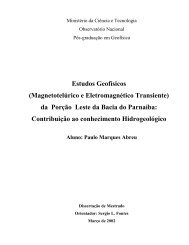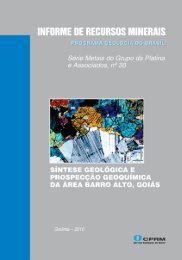Whole-rock geochemistry and Sr-Nd isotopic composition of ... - CPRM
Whole-rock geochemistry and Sr-Nd isotopic composition of ... - CPRM
Whole-rock geochemistry and Sr-Nd isotopic composition of ... - CPRM
Create successful ePaper yourself
Turn your PDF publications into a flip-book with our unique Google optimized e-Paper software.
62<br />
Sample preparation followed the procedures described by Alves<br />
(1987), with slides undergoing three preparations, from which<br />
three spectra were obtained (st<strong>and</strong>ard, glycolated, <strong>and</strong> calcined);<br />
their combined interpretation was used to identify the clay<br />
minerals present in the samples, since their physical <strong>and</strong> chemical<br />
characteristics show different responses to the treatments.<br />
After these procedures, we performed the analyses, compared<br />
the diffractograms, <strong>and</strong> identified the clay minerals by st<strong>and</strong>ard<br />
Fig. 4. Picture showing the Camamu 4 outcrop.<br />
D.R.A. Silva et al. / Journal <strong>of</strong> South American Earth Sciences 39 (2012) 59e71<br />
Fig. 3. Camamu Basin area showing the sample location.<br />
procedure according to Brown <strong>and</strong> Brindley (1980) from the<br />
measure <strong>of</strong> the height <strong>of</strong> the major peaks.<br />
4. Results<br />
4.1. Classification <strong>and</strong> <strong>composition</strong> <strong>of</strong> the <strong>rock</strong>s analyzed<br />
Macroscopically <strong>and</strong> as described previously, the samples<br />
investigated were reddish pelites, locally with carbonate nodules,<br />
always with white mica fragments.<br />
Clay fractions <strong>of</strong> the Camamu 2, 3, 4, <strong>and</strong> 5 samples are constituted<br />
mainly <strong>of</strong> illite (I), smectite (S), interstratified illite-smectite<br />
(IS) as traces, <strong>and</strong> possibly quartz <strong>and</strong> K-feldspar. Kaolinite (K),<br />
illite (I), <strong>and</strong> quartz traces prevailed in the Camamu 1 samples.<br />
The <strong>rock</strong>s analyzed were classified according to the method<br />
proposed by Herron (1988), which, according to Roddaz et al.<br />
(2006), is appropriate for clastic clay <strong>rock</strong>s (Fig. 5).<br />
In the present proposition, most samples analyzed can be classified<br />
as Fe-shales. These samples are characterized by high levels<br />
<strong>of</strong> Fe2O3 (8e12%, Table 1). Following Kasanzu et al. (2008), this is<br />
a good descriptive classification to these <strong>rock</strong>s.<br />
4.2. 87 <strong>Sr</strong>/ 86 <strong>Sr</strong> ratios <strong>and</strong> the “pseudo-isochrons”<br />
Initially, the 87 <strong>Sr</strong>/ 86 <strong>Sr</strong> <strong>and</strong> 87 Rb/ 86 <strong>Sr</strong> results were plotted in an<br />
isochron diagram (according to the model <strong>of</strong> Ludwig, 2003). The<br />
purpose was to the verify the possibility <strong>of</strong> establishing the depositional<br />
age, since this method has been successfully applied to


